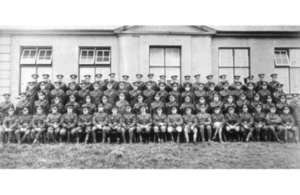Dstl recalls the contribution of the Civil Service during WW1
As we mark the centenary of the end of World War One, Dstl especially remembers the large number of Civil Service volunteers who enlisted in the Armed Forces.

Crown copywrite Dstl: Porton Down during WW1
During the 1914-18 conflict, three Battalions of Infantry were formed from Civil Servant volunteers drawn from across the Government Departments.
Long before WWI, the Civil Service had recognised the benefits of military service and actively encouraged its employees to join. Following the outbreak of war, Civil Servants from across the capital were eager to exchange pens for rifles and be directly involved in the fighting. The Civil Service Rifles lobbied the Prime Minister and supporters in the House of Lords arguing that replacements for their day jobs should be urgently found, exclaiming that, ‘Civil servants are burning to do something for this country in this hour of need.’ In parallel, the Regiment prepared itself through a programme of drill, rifle training, route marches and practice attacks in the streets and parks of central London.
In the pre-war years, approximately eighty per cent of the population was employed in manual labour. With its meritocratic system of advancement, the Civil Service offered social mobility to those seeking to enter a white-collar profession. As a result, members of the Civil Service Rifles were well-educated, self-disciplined and used to working within a hierarchical organisation. New recruits would always begin as privates, regardless of Civil Service grade, with officers being promoted from the ranks. Relationships between the ranks were friendly and respectful, which proved a significant factor in maintaining morale during WWI, sustaining them through the most appalling experiences and losses.
The 1st Battalion won twelve battle honours in France, including Loos, Vimy Ridge, Ypres and the Somme. Life in the trenches in France was typically desperate; writing from a waterlogged section of the line near Vermelles, Lt Roberts wrote: ‘Mud up to your eyes, incessant shelling, unceasing rain… we had a hell of a time.’ The 2nd Battalion won a further eleven battle honours in places as far-flung as France, the Balkans and the Middle East. Meanwhile, the 3rd Battalion remained in London to train reinforcements. These were required not only to replace the many casualties, but also the hundreds of members of the Civil Service Rifles who were given officer training and commissioned into other Units.
As with all Regiments, the Civil Service Rifles were accompanied by Army Chaplains, who provided pastoral support and spiritual guidance, whilst sharing the dangers and hardships of battle. The Reverend Edward Beattie served with the 1st Battalion and was awarded the Military Cross in France in 1918. It is therefore fitting that after the war, Rev Beattie helped dedicate the Civil Service Rifles memorial.
If you walk from this church just 20 minutes north along the river, you will find Somerset House, which was originally built for the Civil Service and became the Regiment’s Headquarters and drill ground until its disbandment in 1921. There on the riverside terrace is a war memorial, designed by Sir Edwin Lutyens and unveiled by the then Prince of Wales, the Regiment’s Honorary Colonel, in January 1924.
It commemorates the 1,240 members of the Civil Service Rifles who fell in the First World War. The Regiment held Remembrance Sunday services at the memorial until the late 1980s, by which time many veterans were in their nineties. A rededication ceremony in 2002 was attended by relatives of former members and ex-Private Walter Humphrys, the last known surviving veteran of the Regiment from World War I. A small, frail but alert figure in a wheelchair, Walter attended just a few weeks short of his 105th birthday to honour the men with whom he served. As he left Somerset House for the final time, he was heard to say of his former comrades, ‘You never forget them, you know… you never forget.’
With acknowledgements to Jill Knight’s book, ‘The Civil Service Rifles in the Great War’.